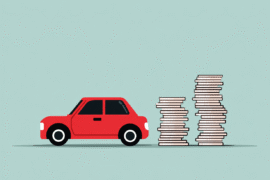This article may contain references to products or services from one or more of our advertisers or partners. We may receive compensation when you click on links to those products or services. Nonetheless, our opinions are our own.
The information presented in this article is accurate to the best of our knowledge at the time of publication. However, information is subject to change, and no guarantees are made about the continued accuracy or completeness of this content after its publication date.
- Key Highlights
- Introduction
- Understanding Loans After Bankruptcy
- Preparing to Apply for Loans Post-Bankruptcy
- Beginner’s Guide to Applying for Loans After Bankruptcy
- Strategies for Successful Loan Approval
- Alternatives to Traditional Personal Loans
- Conclusion
- Frequently Asked Questions
- Recommended Reads
Key Highlights
- Filing for bankruptcy can significantly lower your credit score, making it harder to get loans.
- Loans are still available after bankruptcy but expect higher interest rates and additional fees.
- Rebuilding credit is essential. Paying on time and using secured credit cards can help.
- Loan options include secured loans, credit builder loans, and lenders specializing in post-bankruptcy borrowers.
- Reviewing loan terms, comparing offers, and budgeting carefully can prevent financial setbacks.
- Rebuilding credit takes time and requires responsible money management.
Introduction
Life after filing for bankruptcy can feel like a fresh financial start but comes with challenges, especially when seeking loans. Bankruptcy might seem like a major setback, but it does not mean financial recovery is impossible. This guide provides essential tips and information to help you understand loan options, rebuild credit, and achieve financial stability after bankruptcy.
Understanding Loans After Bankruptcy
Bankruptcy, whether Chapter 7 or Chapter 13, remains on your credit report for several years, signaling financial struggles to lenders. As a result, obtaining a loan after bankruptcy can be difficult.
Many lenders are willing to work with borrowers post-bankruptcy, recognizing that financial difficulties can happen to anyone. However, these loans often come with stricter conditions, including higher interest rates, larger down payments, and shorter repayment periods. These measures help lenders mitigate risk when lending to individuals with bankruptcy in their credit history.
The Impact of Bankruptcy on Your Credit
Your credit score reflects how well you manage debt, based on your credit history. Filing for bankruptcy significantly lowers your credit score, making it challenging to secure favorable loan terms.
Lenders assess credit scores to determine risk levels. A low score signals higher risk, affecting loan approvals and interest rates. The extent of score reduction depends on several factors, including your prior credit standing and the type of bankruptcy filed.
Despite this, credit scores can be improved over time. Responsible financial management, such as paying bills on time and maintaining a low debt-to-income ratio, can gradually rebuild credit and improve loan eligibility.
Types of Bankruptcies and Their Effects on Lending
The type of bankruptcy filed affects how long it remains on your credit report and influences loan approval chances. The two most common types are Chapter 7 and Chapter 13 bankruptcy.
- Chapter 7 bankruptcy requires selling assets to pay off debts and remains on your credit report for up to 10 years.
- Chapter 13 bankruptcy involves a structured repayment plan and stays on your credit report for up to 7 years.
While Chapter 13 allows borrowers to demonstrate a commitment to repaying debt, lenders may still view it as a financial hardship, potentially affecting loan approval chances. Understanding these differences can help in making informed financial decisions.
Preparing to Apply for Loans Post-Bankruptcy
Before applying for a loan after bankruptcy, assess your financial situation, gather essential documents, and set realistic expectations regarding available loan options. Proper preparation increases approval chances and improves loan terms.
Essential Documents and Information You’ll Need
A successful loan application requires the following documents:
- Credit report – Demonstrates your financial history and highlights areas of improvement.
- Proof of income – Pay stubs or tax returns assure lenders of your ability to repay the loan.
- List of current debts – Helps lenders evaluate your debt-to-income ratio.
Providing clear financial documentation reassures lenders and improves loan approval chances.
Assessing Your Financial Standing
Before applying for a loan, review your income, expenses, and existing debts. Obtain your credit report from the three major credit bureaus—Equifax, Experian, and TransUnion—to understand your credit profile.
If your credit score is significantly low, consider improving it before applying for a loan. A higher score increases the likelihood of securing better loan terms and reduces financial strain.
Voted "Best Overall Budgeting App" by Forbes and WSJ
Monarch Money helps you budget, track spending, set goals, and plan your financial future—all in one app.
Get 50% OFF your first year with code MONARCHVIP
Beginner’s Guide to Applying for Loans After Bankruptcy
Applying for a loan post-bankruptcy is manageable with patience and thorough research. Following a structured approach can lead to successful loan approval and credit improvement.
Importance of Rebuilding Your Credit
A strong credit score is crucial for obtaining loans with better terms. Lenders assess creditworthiness based on payment history and responsible financial behavior.
- Paying bills on time establishes reliability.
- Using a secured credit card and making timely payments can enhance credit scores.
- Avoiding unnecessary debt prevents further financial difficulties.
Rebuilding credit is a gradual process requiring discipline and consistency.
Finding Bankruptcy-Friendly Lenders
Not all lenders are accommodating to individuals with a bankruptcy on their credit reports While traditional banks may be cautious, online lenders and credit unions often have more flexible lending policies.
Consulting a bankruptcy attorney or financial advisor can provide recommendations for reputable lenders specializing in post-bankruptcy lending. Researching lender terms and reading customer reviews can help identify the best options.
Step 1: Review Your Credit Report
Obtain a free credit report from Equifax, Experian, and TransUnion. Check for inaccuracies and dispute any errors. Lenders assess credit history to determine risk, making it essential to present accurate information.
Step 2: Research Potential Lenders
When seeking a loan after bankruptcy, compare lenders based on:
- Loan amount – Borrow only what is necessary to avoid excessive debt.
- Interest rates – Look for competitive rates to minimize repayment costs.
- Fees – Consider origination fees, late payment fees, and prepayment penalties.
Comparing loan terms ensures selecting the most suitable option.
Step 3: Prepare Necessary Documentation
Gather proof of income, address verification, and bank statements. A well-prepared application demonstrates responsibility to lenders. Including an explanation letter detailing steps taken to improve financial stability can further strengthen the application.
Step 4: Apply for Pre-qualification
Many lenders offer pre-qualification tools that assess eligibility without impacting credit scores. Pre-qualification provides insights into potential loan terms and lenders willing to approve applications.
Step 5: Compare Loan Offers and Conditions
Evaluate interest rates, fees, and repayment terms. The annual percentage rate (APR) reflects the total loan cost. A shorter repayment term results in higher monthly payments but lower total interest, while a longer term reduces payments but increases the overall cost. Selecting the most affordable option prevents financial strain.
Strategies for Successful Loan Approval
Improving creditworthiness enhances loan approval chances. Consider the following strategies:
- Save for a larger down payment – Reduces lender risk and improves loan terms.
- Obtain a cosigner – A cosigner with good credit strengthens applications and may lower interest rates.
- Demonstrate responsible financial behavior – Consistently making timely payments builds lender confidence.
Alternatives to Traditional Personal Loans
If securing a personal loan is challenging, consider alternative financing options designed to rebuild credit and provide necessary funds.
Secured Loans and Their Benefits
Secured loans require collateral, such as a car or savings account, to reduce lender risk. These loans typically have lower interest rates and are easier to qualify for compared to unsecured loans. However, failing to make payments can result in asset loss.
Considering Credit Builder Loans
Credit builder loans hold loan funds in an account while borrowers make fixed monthly payments. Upon completion, the total amount is released, helping establish a positive payment history. These loans are effective for credit improvement and financial stability.
Conclusion
Rebuilding credit after bankruptcy is challenging but achievable. Understanding how bankruptcy affects credit, exploring loan options, and implementing financial strategies can facilitate recovery. Researching lenders, checking credit reports, and considering secured or credit builder loans contribute to financial improvement. Patience and consistency are essential in regaining financial health.
Frequently Asked Questions
How soon can I apply for a loan after bankruptcy?
You can apply for a loan once your bankruptcy is discharged. However, waiting to build a positive credit history improves loan terms and approval chances.
What types of loans are easier to get post-bankruptcy?
Secured loans, such as secured credit cards and auto loans, are generally easier to obtain due to reduced lender risk.
Can having a cosigner improve my chances of loan approval?
Yes, a cosigner with good credit can strengthen your loan application and potentially lower interest rates.
Are there specific lenders who specialize in post-bankruptcy loans?
Certain online lenders and credit unions offer specialized loans for individuals recovering from bankruptcy. Consulting a bankruptcy attorney or financial advisor can guide suitable lenders.

Reviewed and edited by Albert Fang.
See a typo or want to suggest an edit/revision to the content? Use the contact us form to provide feedback.
At FangWallet, we value editorial integrity and open collaboration in curating quality content for readers to enjoy. Much appreciated for the assist.
Did you like our article and find it insightful? We encourage sharing the article link with family and friends to benefit as well - better yet, sharing on social media. Thank you for the support! 🍉
Article Title: Loans After Bankruptcy: Best Lenders and Tips for Rebuilding
https://fangwallet.com/2025/03/20/loans-after-bankruptcy/The FangWallet Promise
FangWallet is an editorially independent resource - founded on breaking down challenging financial concepts for anyone to understand since 2014. While we adhere to editorial integrity, note that this post may contain references to products from our partners.
The FangWallet promise is always to have your best interest in mind and be transparent and honest about the financial picture.
Become an Insider

Subscribe to get a free daily budget planner printable to help get your money on track!
Make passive money the right way. No spam.
Editorial Disclaimer: The editorial content on this page is not provided by any of the companies mentioned. The opinions expressed here are the author's alone.
The content of this website is for informational purposes only and does not represent investment advice, or an offer or solicitation to buy or sell any security, investment, or product. Investors are encouraged to do their own due diligence, and, if necessary, consult professional advising before making any investment decisions. Investing involves a high degree of risk, and financial losses may occur including the potential loss of principal.
Source Citation References:
+ Inspo
There are no additional citations or references to note for this article at this time.












































